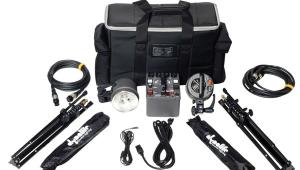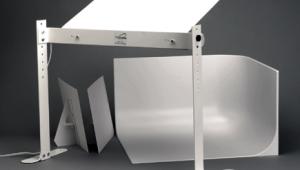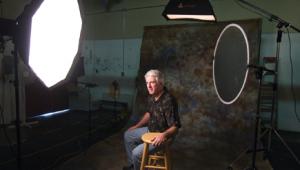Using Older Electronic Flash With Digital Cameras; What Works—What Doesn’t
If you are relatively new to photography and have only digital cameras along with newer digital-oriented versions of major accessories, everything you have should be compatible and work properly together. But if you have been actively involved with photography for many years through the film-based era, you undoubtedly have older accessories designed for use with film cameras that you would also like to use with your new digital cameras. Often you will discover that these older items are not fully compatible with today’s digital camera electronics even if they were made by the camera’s manufacturer. We intend to clarify just how you can successfully and safely use your older accessories, in this case portable and AC-powered electronic flash units.
One of the major potentially serious problems with older hot shoe flash units is that they may have a high trigger voltage. There is an ISO (International Standards Organization) standard that states that the trigger voltage for flash unit ignition circuits should be 24v or less. But, many older hot shoe flashes and some larger, studio-type AC-powered flashes have a much higher trigger voltage—often up to 400v—which could damage digital camera circuitry. Maximum voltage recommendations vary from firm to firm and camera to camera. For instance, Nikon says their digital cameras are safe for up to 250v from flash units. Canon recommends 6v or less for some digital models, while others are said to be safe up to 250v.
How can you tell if the unit is compatible or will fry circuits? A digital rapid response meter used by professional repair facilities can measure the voltage of various models of flash units. But what further complicates the entire high voltage situation is that on some flash units the voltage measured across the tip of the PC cord contacts can vary from the voltage measured at the hot shoe—on the same flash. What this boils down to is this is an ambiguous subject with no hard and fast standards.
How do you know if your older flash is a high voltage model? Just the name on my 20 plus-year-old Vivitar 285HV (High Voltage) is a dead giveaway for this potentially dangerous trait. But with other older hot shoe flash units it’s difficult to determine. You can check the following website to find out the trigger voltage of your brand and model of hot shoe flash since the instruction books don’t provide this type of information. Just visit www.botzilla.com/photo/strobeVolts.html. There you will find voltage measurements for different flash units plus lots of other helpful information on this subject.
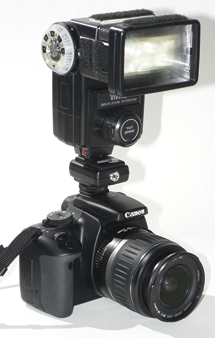 |
Flash Unit “Transformers”
The primary potential danger from using older flash units is they typically use a high 200-400v trigger voltage, which could seriously damage the circuitry of a digital camera. New flash units specifically designed for use with digital cameras don’t have this problem. But you can safely use your older flash unit if it is interfaced with a small shoe-mount device that slides onto the camera’s hot shoe before you attach the shoe-mount flash to reduce the voltage. After extensive web searching and contacting firms, I found three brands of this type of device that are available for well under $100. However, it might be more cost effective to purchase a small new hot shoe flash that’s digitally compatible rather than buying a safe sync device in order to safely use your older model hot shoe flash. Large studio flash units also have high trigger voltage and can be used with this type of voltage reduction interface through the PC contact found on the small unit.
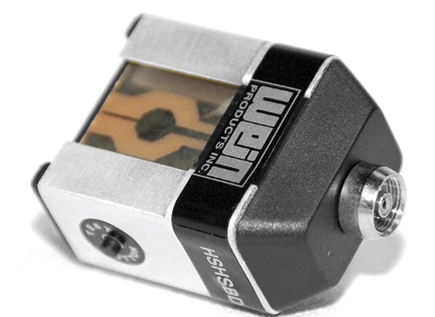 |
|
|
One shoe interface, and probably the best known, is the Wein Safe-Sync from OmegaSatter that lists for $70. It reduces the flash voltage from up to 400v down to a safe 6v, which won’t damage the camera. It has a PC contact so it can also be used with handle-mount or studio-type units that don’t have a shoe. The High-Voltage Safe Converter from Booth Photographic regulates and reduces the high voltage produced by older hot shoe flash units for safe operation with digital cameras. This battery-operated device slides onto the hot shoe between the shoe-mount flash and the camera. An LED indicates when the battery is OK. There is a PC terminal for use with flashes having a PC cord sync. It has an MSRP of $73. The OPUS OPL-Sync Protect (Nadel Enterprises) attaches to the hot shoe of digital cameras. It reduces flash voltage of up to 400v down to a safe 6v. There is a test button to fire the flash and a PC contact for use with handle-mount flashes. The MSRP is $29.
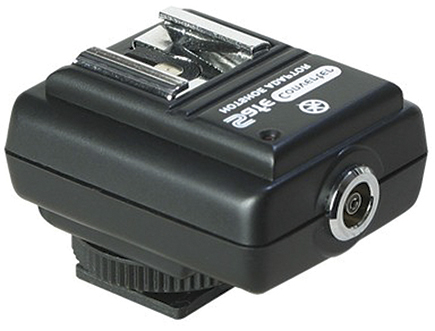 |
|
|
Automation?
If your older auxiliary flash had TTL metering capability with your film camera, then you will not be able to use this feature when this flash is used with your digital camera. If the flash has a built-in sensor for automatic operation, then you will still be able to use this type of less sophisticated automation, but you will have to preset the shutter speed and lens aperture by setting the camera operation to manual. Of course, you can always use the Guide Number (GN) system found on the flash and set the digital camera to the aperture and shutter speed needed for the estimated flash-to-subject distance. Many flash units have either a graph or digital read-out that gives the recommended aperture to use for various flash-to-subject distances to assist in making the necessary aperture settings.
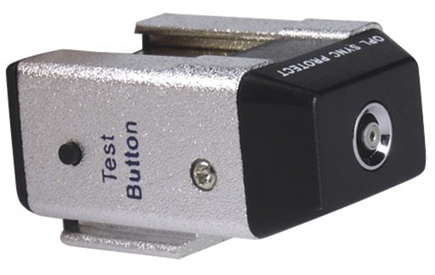 |
|
|
Slave Flash
Another potential problem occurs if you try using an older model slave flash with the built-in flash on a digital camera. The slave will fire, but unless it’s a slave designed for use with digital products it will not sync properly. Older slave flash technology sensors detect when a flash fires, then immediately fire the slave. But a digital camera typically fires a weaker pre-flash used for autofocusing or white balance, then milliseconds later, the more powerful main picture-making flash. Unfortunately, the sensor on the slave flash detects only the first flash and then immediately fires the slave—prematurely and out of sync—since the camera shutter is not yet open. The slave flash cannot recycle and recharge rapidly enough to fire again when the second main flash fires.
 |
|
|
An electronic flash fires so quickly (often 1⁄1000 sec or shorter) that your eye believes the slave flash fired properly—but it does not. With digital cameras you can check the captured image on the LCD so you will probably notice if the light from the slave has not recorded. To obtain slave flash compatibility, you must use a newer model slave flash having adjustable sensing sensitivity that can be preset to fire the slave either on detection of the first flash or only after the second flash is fired. To accomplish this you can either purchase a small slave attachment with adjustable sensor timing, or another slave-capable flash unit having an adjustable sensor.
Note: Compact digital cameras base their exposure only on the light emitted by the internal built-in flash and won’t make adjustments for the additional light from a slave flash, but when the slave is used for side or backlighting to better illuminate the subject, it should not adversely affect the exposure. A more powerful slave flash will extend the reach of the generally weak camera flash to give better exposure on more distant objects.
Caution: If you use a slave flash in a situation when other people are also taking flash pictures, when any flash fires, the slave flash will fire. Since they don’t recycle very fast, it might not be recharged and ready when you want to take your picture. You can adapt a slave flash so it will only fire when your camera shutter is released if you use a multi-channel radio sensor. Don’t try to use a slave flash with your camera set for redeye reduction as the multiple up-front flashes will result in premature firing of the slave.
Compact digital cameras often don’t have a hot shoe for attaching an auxiliary flash. There are some small slave flash units designed specifically for this situation. Several are slave-only flashes while others have both Auto and Slave modes. The slave is adjustable so it can be triggered by either a first or second flash and thus can be used with many different digital cameras. Most flashes include a bracket so they can be attached to the camera’s tripod socket for easier portability. For example, the Metz 28 CS-2 digital Slave Flash is intended for use with small digital cameras that do not have either a hot shoe or PC cord contact. It uses “Easy mode” technology to automatically fine-tune the unit to the output of the camera, ignores any pre-flash, and then fires the slave flash. A bracket is built into this 3.4x2.4x1.3” unit; it lists for $120.
If you have an older hot shoe-mount flash unit without a built-in slave, you can adapt it for use with any digital camera by connecting it to a small Morris DS-1 Digital Slave Trigger that sells for $39. Any shoe-mount flash can be connected to it, and then the shoe base can be used with a 1⁄4-20 tripod screw. The built-in flash sensor (slave) can be adjusted for normal or pre-flash cameras. It’s tiltable so you can alter the angle of the flash unit.
 |
|
|
The Morris Midi Slave Flash Di measures 1.2x2.4x2.5” and weighs about 3 oz without the two AA-size batteries. The flat base makes it easy to sit it wherever you want. It has a GN of 42 and a 1⁄4-20 socket so it can be attached to a tripod or light stand to be positioned most anywhere. One switch sets the mode for use with cameras having a normal flash or with those using a pre-flash typically found on most digital cameras. You can even adjust the power level to Low when less light is desired. The MSRP is $89.
 |
|
|
OmegaSatter has the Phoenix D92-BZS digital slave flash with a GN of 92, and a head with zoom, bounce, and swivel. It’s compatible with digital cameras having a hot shoe and also works as a slave flash on a bracket that’s included. The MSRP is $40.
 |
|
|
The Sunpak PF20XD is a very small flash measuring 3.3x1.1x1.2” and weighing only 3.6 oz. It has an ISO of 100 and a GN of 66. The Auto mode has a three-stop range. Although it has a hot shoe, there is a small bracket included so it can be attached to any camera’s tripod socket and fired as a slave when the camera’s flash fires. The street price is $70.
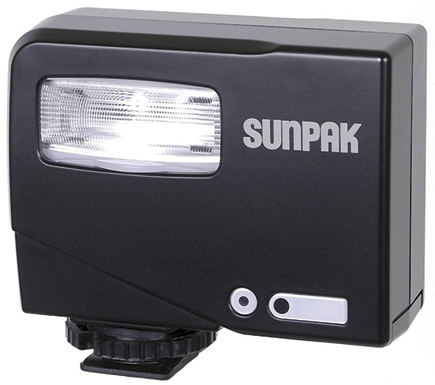 |
|
|
The Zeikos ZE-DS12 is a new moderately-priced digital camera slave flash that comes with a bracket, has a GN of 46, and an MSRP of $25. The Zeikos ZE-DS24, also new, is compact but includes a power grip bracket in the handle mount with extra batteries for longer operating time. The GN is 46 and the MSRP is $25.
 |
 |
||
|
|
Wireless Syncing Devices
Infrared and radio tripper units allow you to “wirelessly” and safely fire most any accessory flash (especially large AC-powered studio flash units) to sync with your digital camera. Since only the transmitter is attached to your camera, there is no way for excessive voltage in the accessory flash to get back to the camera. A small transmitter fits into your camera’s hot shoe and sends a signal to one or more auxiliary flash units to fire them in perfect synchronization with the camera. You will need both a transmitter and receiver with most versions of this accessory. If using several extension
flash units you will need a receiver on each flash.
Some versions of transmitters send an infrared signal and since some AC-powered flash units have a built-in IR receptor you won’t need a receiver for them. Infrared devices operate over great distances (typically a maximum range of 100 to over 400 ft). One drawback is that infrared devices are limited to line-of-sight positioning so the flash must be located in front of the camera. The receiver (if needed) attaches to the flash unit via a plug-in jack (RCA) or standard two-prong plug.
Many models of radio units offer several different preset channels so they can be used in larger studios where more than one photographer is working with wireless triggering devices on different active sets or in sports arenas, again with multiple photographers shooting simultaneously. Radio devices are not limited to line-of-sight positioning so walls and obstructions don’t interfere with the signal. Besides safely firing the flash some distance away, they offer a method of using large AC-powered flash units with digital cameras not having a PC flash terminal but having a hot shoe. Some models also offer a small remote control, which allows you to fire your camera from a remote location—if your camera has an electronic shutter release. Of course, when using a larger AC-powered flash unit you will have to determine exposure by using a handheld flash meter and set the camera for manual operation.






